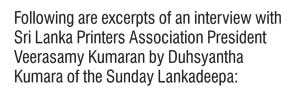Monday Jan 05, 2026
Monday Jan 05, 2026
Thursday, 19 November 2015 00:00 - - {{hitsCtrl.values.hits}}
 Q: Tell us about your entry to the printing industry and your passage to become the President of the Sri Lanka Printers Association?
Q: Tell us about your entry to the printing industry and your passage to become the President of the Sri Lanka Printers Association?
A: I ventured out as a printer in 1979 on a very small scale. At that time offset printing was quite new to Sri Lanka. In 1985 I joined the printing school of the Government press to study printing. After obtaining a diploma in printing I started manufacturing tags for the garment industry. We managed to become a supplier to one of the largest garment manufacturers at that time. I needed to go beyond that and reach out. I joined the Sri Lanka Association of Printers and through them got the opportunity to visit printing exhibitions held in England and Germany every two years.
Those experiences expanded my horizons. I got exposed to modern printing technology. Perseverance and hard work helped me to reach this position. The entire country knows Kumaran through printing. It helped me to build up my life and I’m indebted to this field forever. My commitment to give back something to the industry was the reason I joined the Association over 10 years ago and have now accepted the post of President in the premier organisation of printers in Sri Lanka, to give strength and growth to the 500 printer members of the SLAP.
Q: In what ways does the printing industry impact the economy and development in Sri Lanka?
A: According to my understanding our main export products are garments and tea. The garment industry entered Sri Lanka with the ‘open economic policy’. At the beginning, printing material required for the garment industry was supplied from America and subsequently imported especially from Hong Kong. The development in the printing industry able to match import quality resulted in the availability and supply of these accessory items within Sri Lanka. Our printing industry helped save a large amount of foreign currency from going out of the country.
Most Sri Lankan tea was exported as ‘bulk’ tea initially. The larger tea exporters ventured in to value added exports. The ‘Tea-bag’ concept arrived and with it the requirement of tea tags and cartons. The tea industry needs world class printing for packaging as Sri Lankan tea needs to be displayed on the racks of leading international retailers. Approximately 25% of the cost of value added tea exports are on account of printing. The printing industry directly gets involved in our major exports of garments and tea.
In addition printing and packaging help product differentiation of many consumer products. Brands play a major role in consumer marketing. They stimulate demand and economic activity. Consequently the print industry is involved directly or indirectly in the promotion and sale of every consumer product, designing and supplying packaging as required.
Q: What are the steps and plan of action the SLAP has taken towards the development and growth of the Sri Lankan printing industry?
A: This organisation was set up in 1956 and we will be 60 next year. At the beginning the office was moved from place to place. The office functioned from the home or printing press of one member to another with one month here and the next month in another place. After about 30-40 years from the inception the Association became properly organised. The Finance Ministry started listening to our views for formulation of the national budget with regard to the needs to develop the printing industry in relation to the impact on the progress and growth of the national economy.
We managed to lobby many concessions for the industry to be competitive and benefit Sri Lankan manufacturers and exporters. The former presidents of our association managed to convince the Government to remove customs duty from printing paper and up to now we enjoy this benefit. 
We understood the requirement of our own office and 17 of our members came forward to contribute Rs. 1 million each. We raised Rs. 35 million within one month, bought the land and commenced construction. Now we are in our own building. We have reached out to members and non-members in all 25 districts island-wide, to give all the facilities they require.
We conduct a grand exhibition named ‘Collate’ every two years. Next one is planned in March 2016. Many foreign suppliers take part in this exhibition enthusiastically. Our objective is to make this a meeting place for suppliers to the printing industry and the printers and expose them to new products, processes and modern efficient technologies. At the same time we select and give awards to printers from all the regions on many categories of printing and also give a grand award to Sri Lanka Master Printer. We actively support regional printers as well as selected schools. SLAP also publishes a quarterly magazine ‘Sri Lanka Print’ and distributes it free to the membership.
Q: How much of a challenge do you think is the modern technological advancement in the media to the Sri Lankan printing industry?
A: It is convenient for the people to read printed matter than from a screen. The best example is the book exhibition held at BMICH every year. Millions of people visit it and buy books. As I know the newspaper readership is also higher now than in previous years. Perhaps internet affected greeting card printing. I personally do not think this new trend is a major cause for alarm to the printing industry. The printing industry can never die!
Q: Why is the younger generation less attracted to the printing industry?
A: This is an abnormal situation. In western countries the children are trained to be independent by the time they reach the age of 16. The parents encourage children to shoulder responsibilities. Our children cannot even select a dress to wear at this age. When they reach 18 there is always friction between parents and children. The parents have not educated their children on important things in their life even by that time. The children get socially isolated. They come out of school living in an imaginary world. They do not know how to find a way to earn a living.
Printing industry is an art. It requires skills as well as training to be a good printer. It can offer great opportunities to earn high income and to improve quality of life. This is no more an ink and grease industry. We started the Sri Lanka Print Media Academy to train young people to take advantage of the many opportunities offered and available in this field. We have commenced several courses in the printing field.
Q: Are you satisfied with the assistance given by the Government and financial institutions to the printing industry?
A: Governments normally respond positively to our requests. We conduct our business respecting the laws of the country and there are no specific difficulties worth mentioning. If our business is profitable and we comply with the requirements, the banks do not hesitate to give loans and facilities.
Q: The printing industry particularly in the North and East got affected badly during the time of conflict. Are there any special initiatives to assist and revive the industry in those areas?
A: Our members work in harmony irrespective of their ethnicity. Even before the conflict came to an end we were conducting training workshops and seminars in affected areas. Recently we conducted a very successful seminar in the East with collaboration of the Export Development Board. Next one will be in Jaffna. We hold such seminars and workshops throughout the island. We will be working to develop training with special emphasis in the North-East.
Q: Do you believe that the print industry should embrace or change towards digital technology in the future as per the global trend?
A: Business persons look at the profitability of a business as well as meeting customer needs. In that perspective digital technology is a must for the future of the printing industry. The demand of customer requirement in the printing industry varies. One customer may require 50 copies of something. If we are to print a smaller quantity in the conventional method the cost is very high. That is not valid anymore with digital printing. Now there are printers who do short runs at very reasonable and low prices using digital technology. Our printers have reached international standard. We are very proud of that. We should be open to reach the international market and therefore get ready to supply the global requirements. We can do that only by marching forward armed with the new technology.
Finally, looking towards developing the Sri Lankan Print Industry in the future, I invite all the printers in Sri Lanka to join the Association and reap the benefits it has to offer. Our telephone numbers are 011- 2741 979 and 2741 982. The office and training school is situated at No 21, Mulleriyawa Road, Thalahena, Malabe. Here we conduct training in graphic design, four colour printing and many other subjects required to be a qualified printer. Our facility is well equipped with the most modern machinery, including a modern Japanese four colour printing machine, design and computer facilitation to give our trainees exposure to the ‘state of the art’ technology.
Pic by Alexander Balasooriya